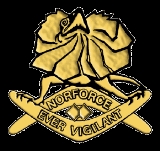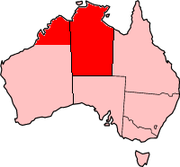
NORFORCE
Encyclopedia

Infantry
Infantrymen are soldiers who are specifically trained for the role of fighting on foot to engage the enemy face to face and have historically borne the brunt of the casualties of combat in wars. As the oldest branch of combat arms, they are the backbone of armies...
regiment
Regiment
A regiment is a major tactical military unit, composed of variable numbers of batteries, squadrons or battalions, commanded by a colonel or lieutenant colonel...
of the Australian Army Reserve
Australian Army Reserve
The Australian Army Reserve is a collective name given to the reserve units of the Australian Army. Since the Federation of Australia in 1901, the reserve military force has been known by many names, including the Citizens Forces, the Citizen Military Forces, the Militia and, unofficially, the...
. Formed in 1981, the regiment is one of three Regional Force Surveillance Units
Regional Force Surveillance Units
"RFSU" redirects here. For the Swedish organization, see Swedish Association for Sexuality EducationThe Regional Force Surveillance Units are specialised infantry units of the Australian Army Reserve responsible for patrolling northern Australia...
(RFSUs) employed in surveillance and reconnaissance of the remote areas of Northern Australia
Northern Australia
The term northern Australia is generally known to include two State and Territories, being Queensland and the Northern Territory . The part of Western Australia north of latitude 26° south—a definition widely used in law and State government policy—is also usually included...
.
History
In the late-1970s and early 1980s the need for a military presence in the north of AustraliaAustralia
Australia , officially the Commonwealth of Australia, is a country in the Southern Hemisphere comprising the mainland of the Australian continent, the island of Tasmania, and numerous smaller islands in the Indian and Pacific Oceans. It is the world's sixth-largest country by total area...
was recognised, with an integrated land, sea and air surveillance network developed in response. Part of this involved the raising of reserve infantry units that would act as "eyes and ears" in the north. NORFORCE was raised for operations in the Northern Territory
Northern Territory
The Northern Territory is a federal territory of Australia, occupying much of the centre of the mainland continent, as well as the central northern regions...
and the Kimberly region of northern Australia and was originally formed as a company
Company (military unit)
A company is a military unit, typically consisting of 80–225 soldiers and usually commanded by a Captain, Major or Commandant. Most companies are formed of three to five platoons although the exact number may vary by country, unit type, and structure...
on 1 July 1981, from the 7th Independent Rifle Company, based in Darwin
Darwin, Northern Territory
Darwin is the capital city of the Northern Territory, Australia. Situated on the Timor Sea, Darwin has a population of 127,500, making it by far the largest and most populated city in the sparsely populated Northern Territory, but the least populous of all Australia's capital cities...
under Lieutenant Colonel John George. This was renamed as the North-West Mobile Force, or NORFORCE, in 1981. Meanwhile in 1985 two more RFSUs were raised, with the Pilbara Regiment
Pilbara Regiment
The Pilbara Regiment is an infantry regiment of the Australian Army Reserve and is one of three Regional Force Surveillance Units employed in surveillance and reconnaissance of the remote areas of northern Australia...
established in Western Australia, and the 51st Battalion, Far North Queensland Regiment
Far North Queensland Regiment
The 51st Battalion, Far North Queensland Regiment is a light infantry battalion of the Australian Army. The battalion serves as a Regional Force Surveillance Unit , carrying out reconnaissance and surveillance tasks as its primary role...
established in Cape York, in Far North Queensland
North Queensland
North Queensland or the Northern Region is the northern part of the state of Queensland in Australia. Queensland is a massive state, larger than most countries, and the tropical northern part of it has been historically remote and undeveloped, resulting in a distinctive regional character and...
.
The regiment's lineage goes back to 2/1st North Australia Observer Unit
2/1st North Australia Observer Unit
The 2/1st North Australia Observer Unit was an Australian Army reconnaissance unit of World War II. 2/1 NAOU was formed in May 1942 to patrol remote areas of northern Australia and provide warning to the Northern Territory Force of any Japanese landings...
(also known as the "Nackaroos"), which were formed in 1942 as part of the defence of northern Australia from the Japan
Japan
Japan is an island nation in East Asia. Located in the Pacific Ocean, it lies to the east of the Sea of Japan, China, North Korea, South Korea and Russia, stretching from the Sea of Okhotsk in the north to the East China Sea and Taiwan in the south...
ese during the Second World War, performing reconnaissance, scouting and coastal surveillance tasks across the Kimberley and the Northern Territory's sea and air approaches. However, patrols were reduced in July 1943 as the Japanese threat subsided, and the unit was disbanded in 1945. Due to the similarities between the two units and in order to give NORFORCE an identity it was decided that it would perpetuate the NAOU traditions, and as such NORFORCE officially adopted the NAOU's orange and green 'double diamond' colour patch and its unit heritage upon formation.
NORFORCE also shares its heritage with a number of other units raised during the Second World War, including the Darwin Mobile Force
Darwin Mobile Force
The Darwin Mobile Force was a mixed force of infantry and artillery raised by the Australian Army prior to the Second World War. It was the first regular infantry field force in the Australian military, although due to legislative restrictions that existed at the time it was established as part of...
, from which NORFORCE derives its name, and the Northern Territory Special Reconnaissance Unit which performed a similar role to the NAOU and pioneered the enlistment and training of regionally based Aboriginal soldiers, mainly from Arnhem Land
Arnhem Land
The Arnhem Land Region is one of the five regions of the Northern Territory of Australia. It is located in the north-eastern corner of the territory and is around 500 km from the territory capital Darwin. The region has an area of 97,000 km² which also covers the area of Kakadu National...
. The Darwin Mobile Force was raised in 1939, originally as an artillery unit due to restrictions of the Defence Act (1903) which prohibited the establishment of permanent infantry forces, and was the first Permanent Military Force unit to be raised in the Army. The unit was tasked with the surveillance and protection of the Darwin region. Later renamed the Darwin Infantry Battalion in 1942, in 1943 it was again re-named the 19th Battalion, and subsequently saw service during the New Guinea campaign
New Guinea campaign
The New Guinea campaign was one of the major military campaigns of World War II.Before the war, the island of New Guinea was split between:...
.
Today, the regiment is based at Larrakeyah Barracks
Larrakeyah, Northern Territory
Larrakeyah is an inner suburb of Darwin, the capital city of Australia's Northern Territory.-History:Larrakeyah is named after the indigenous language group that occupied the area before European settlement, the Larrakia, who occupied much of the Darwin coastal area.Development of the suburb...
in Darwin, while its area of operation
Area of operation
In U.S. military parlance, an area of operations is an operational area defined by the force commander for land, air, and naval forces conduct of combat and non-combat activities...
covers 1.8 million square kilometres, encompassing the entire Northern Territory
Northern Territory
The Northern Territory is a federal territory of Australia, occupying much of the centre of the mainland continent, as well as the central northern regions...
and the Kimberley region of Western Australia
Kimberley region of Western Australia
The Kimberley is one of the nine regions of Western Australia. It is located in the northern part of Western Australia, bordered on the west by the Indian Ocean, on the north by the Timor Sea, on the south by the Great Sandy and Tanami Deserts, and on the east by the Northern Territory.The region...
; the largest of any military unit in the world today. Borrowing the concept of different "skin" groups to differentiate clans, members of NORFORCE are also known as "Green skins". In 2006, the regiment celebrated its 25th birthday by being presented with its first stand of colours
Colours, standards and guidons
In military organizations, the practice of carrying colours, standards or Guidons, both to act as a rallying point for troops and to mark the location of the commander, is thought to have originated in Ancient Egypt some 5,000 years ago...
. On 1 March 2010, NORFORCE became part of the re-raised 6th Brigade
6th Brigade (Australia)
The 6th Brigade is an Australian Army brigade. First formed during the First World War as an infantry unit of the Australian Imperial Force, the brigade served at Gallipoli and in France and Belgium on the Western Front...
. The primary role of the regiment is reconnaissance, observation and the collection of military intelligence. In the unlikely event of an invasion of northern Australia, NORFORCE and the other RFSUs would operate in a "stay-behind
Stay-behind
In a stay-behind operation, a country places secret operatives or organisations in its own territory, for use in the event that the territory is overrun by an enemy. If this occurs, the operatives would then form the basis of a resistance movement, or would act as spies from behind enemy lines...
" capacity. 60% of NORFORCE personnel are Australian Aboriginal soldiers, drawn mainly from the area they patrol to draw on local knowledge. This has resulted in great trust for the regiment among Aboriginal communities.

